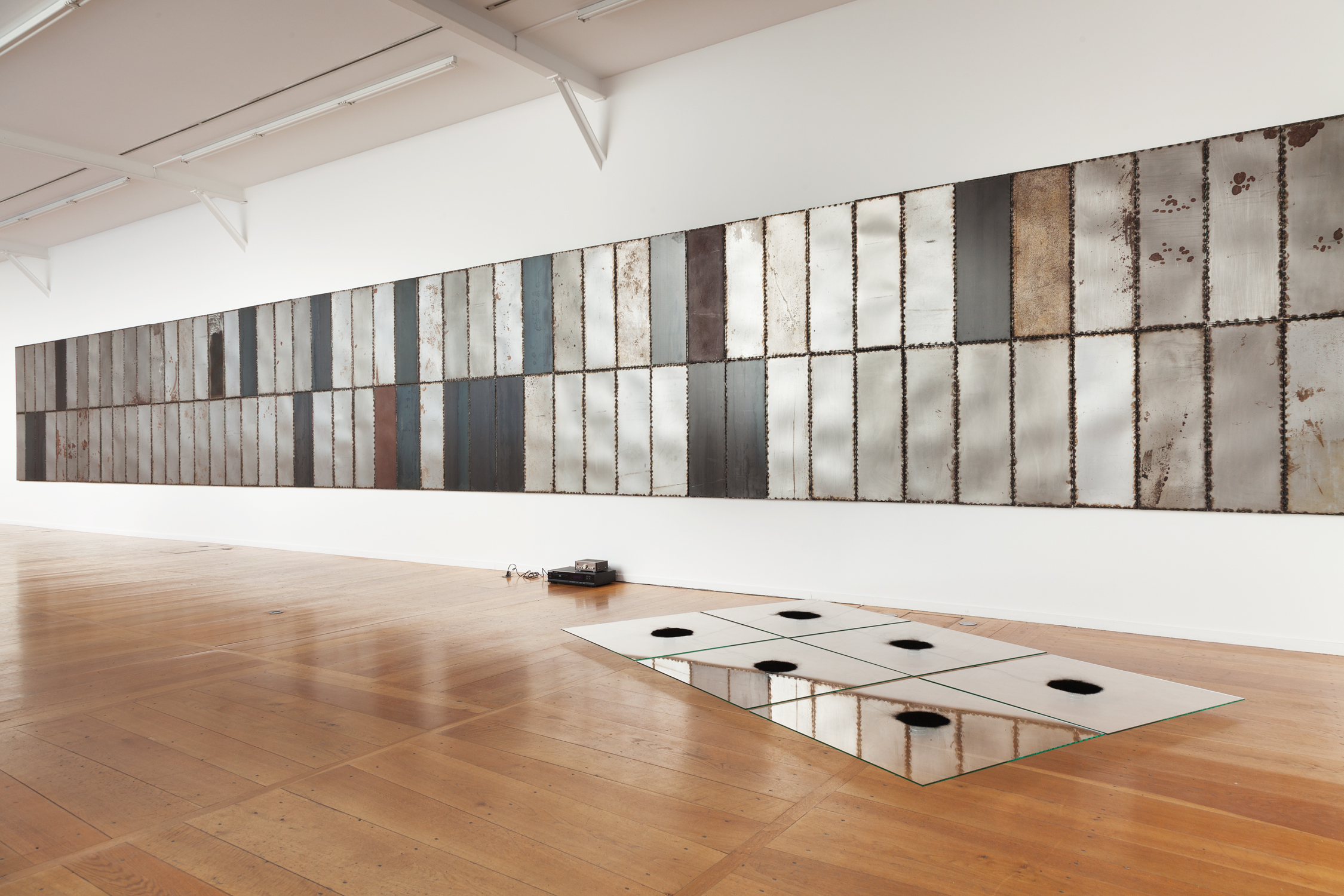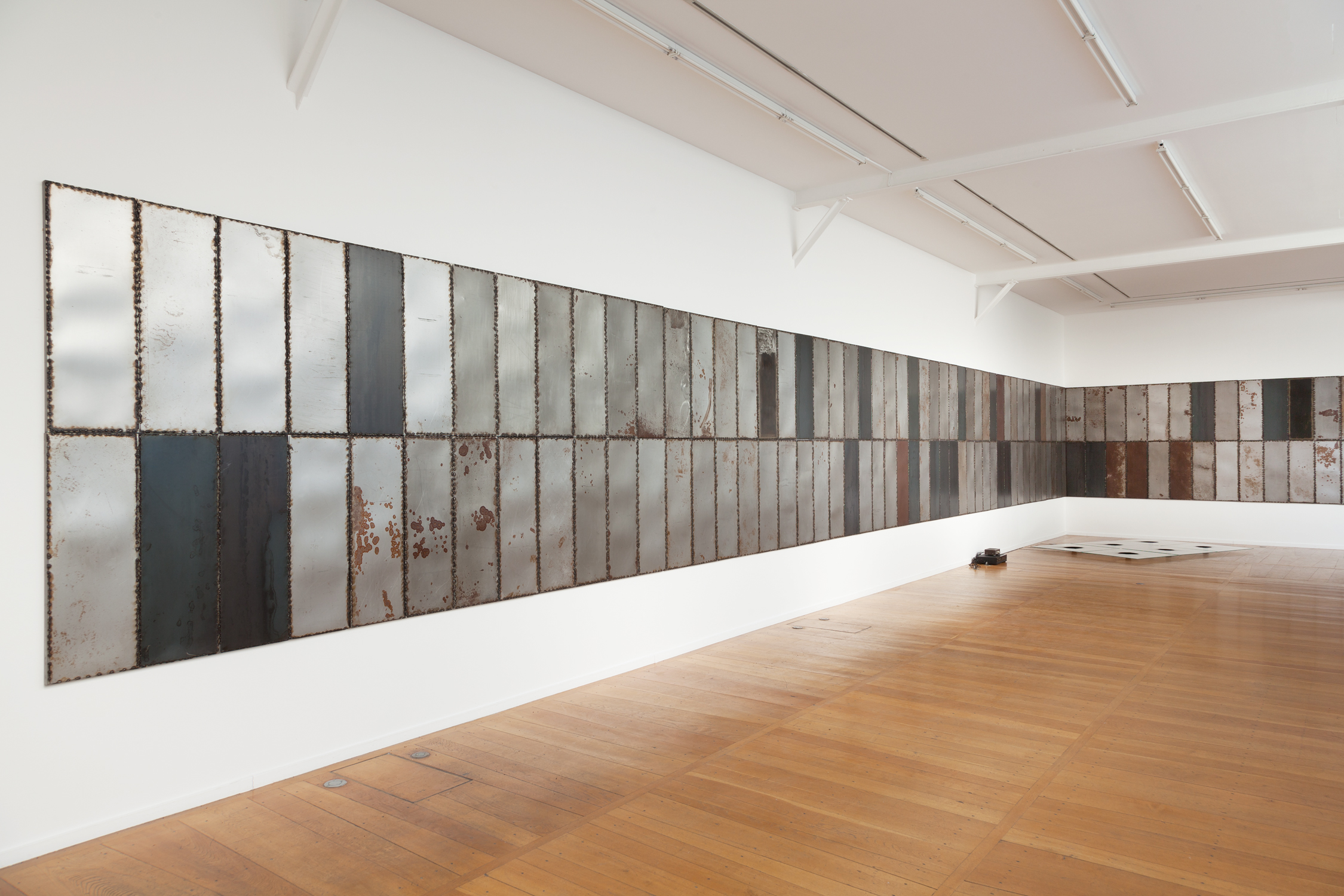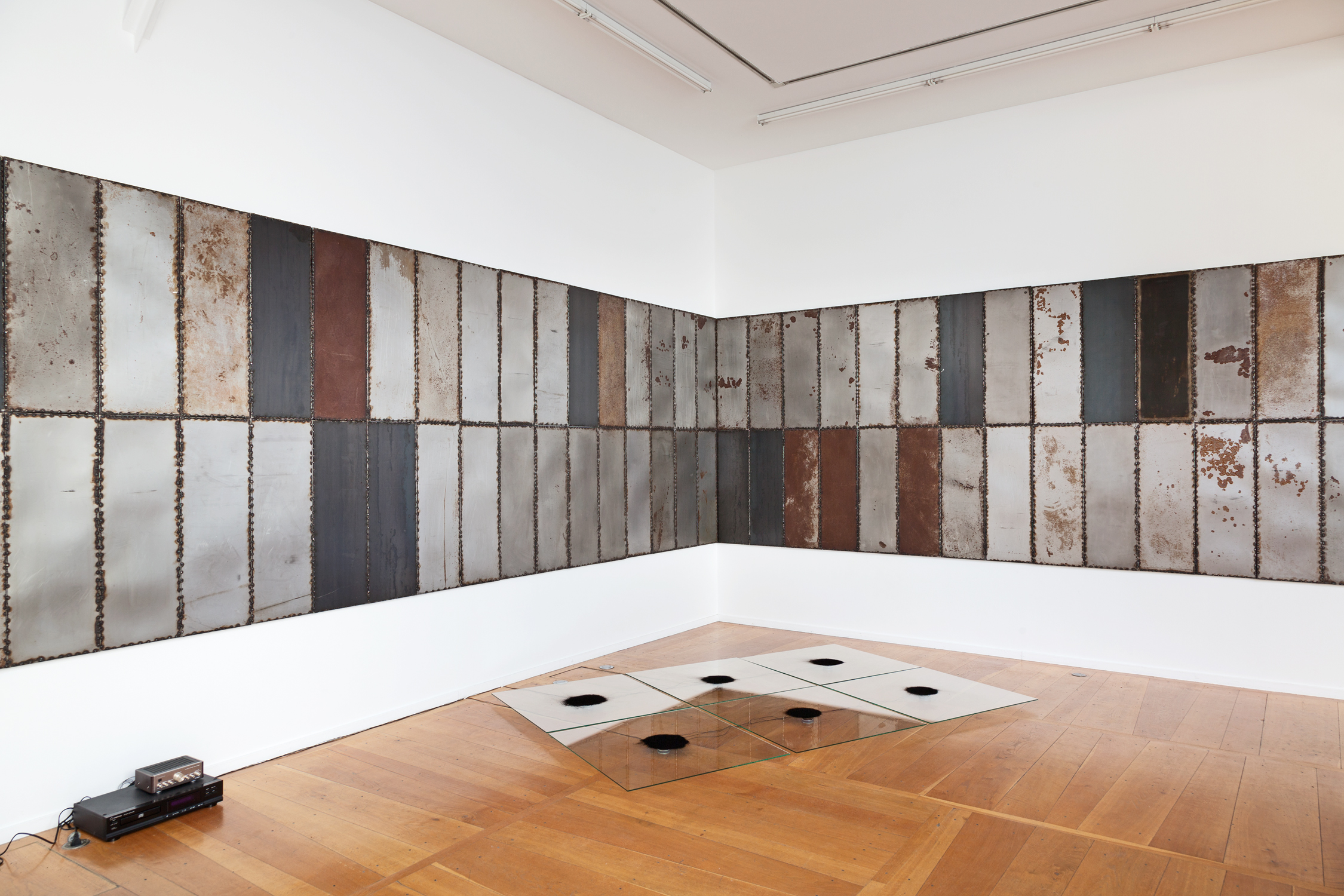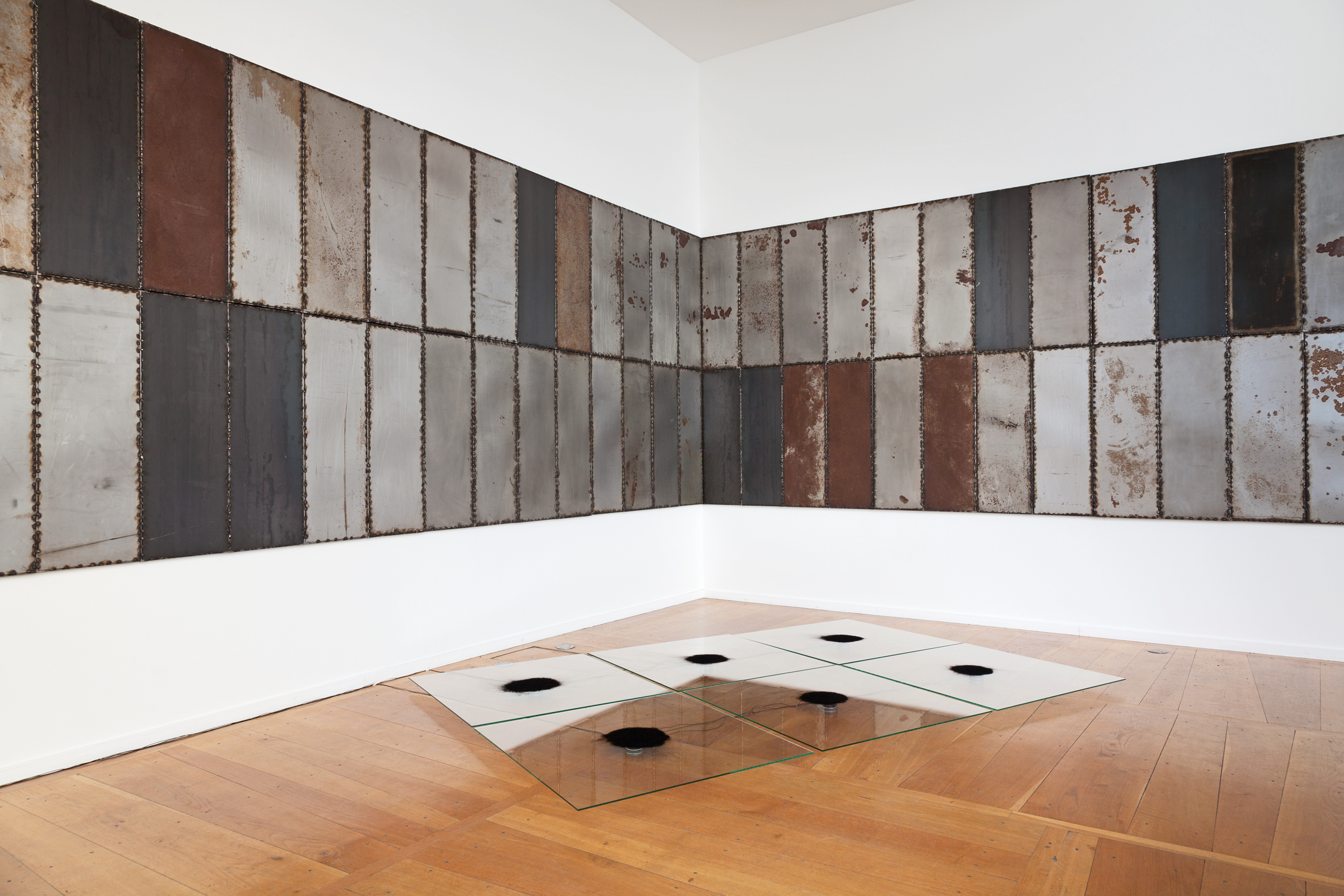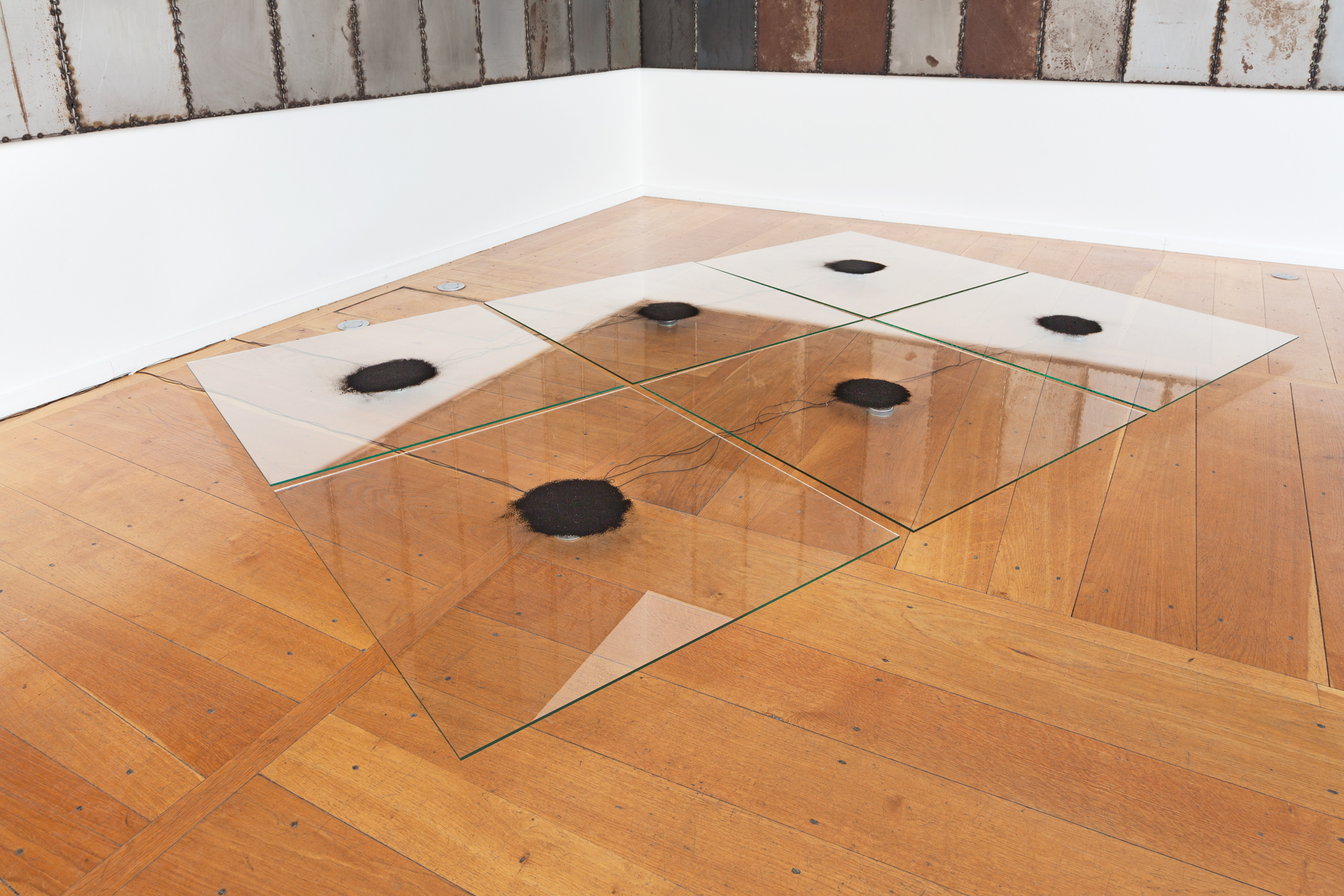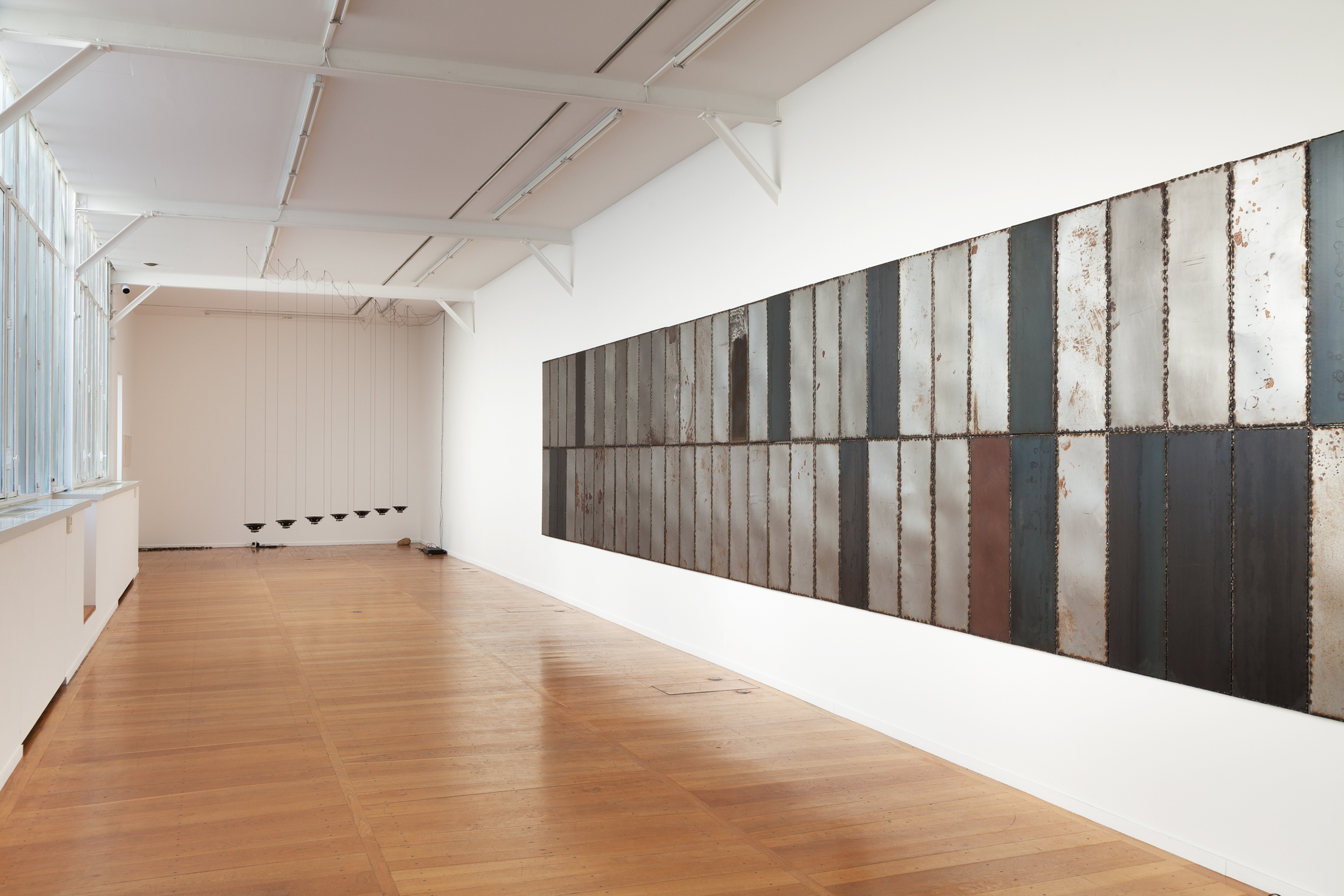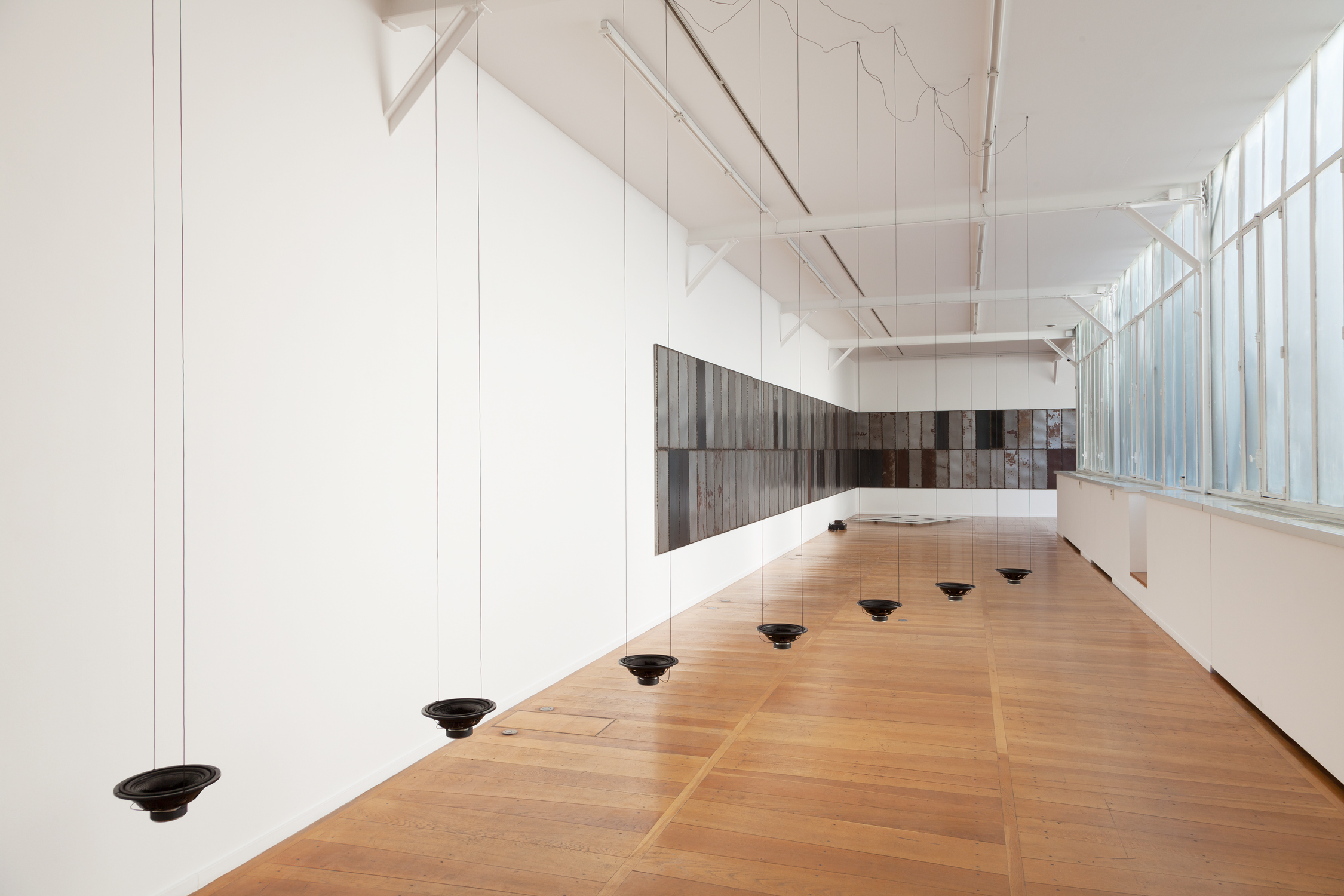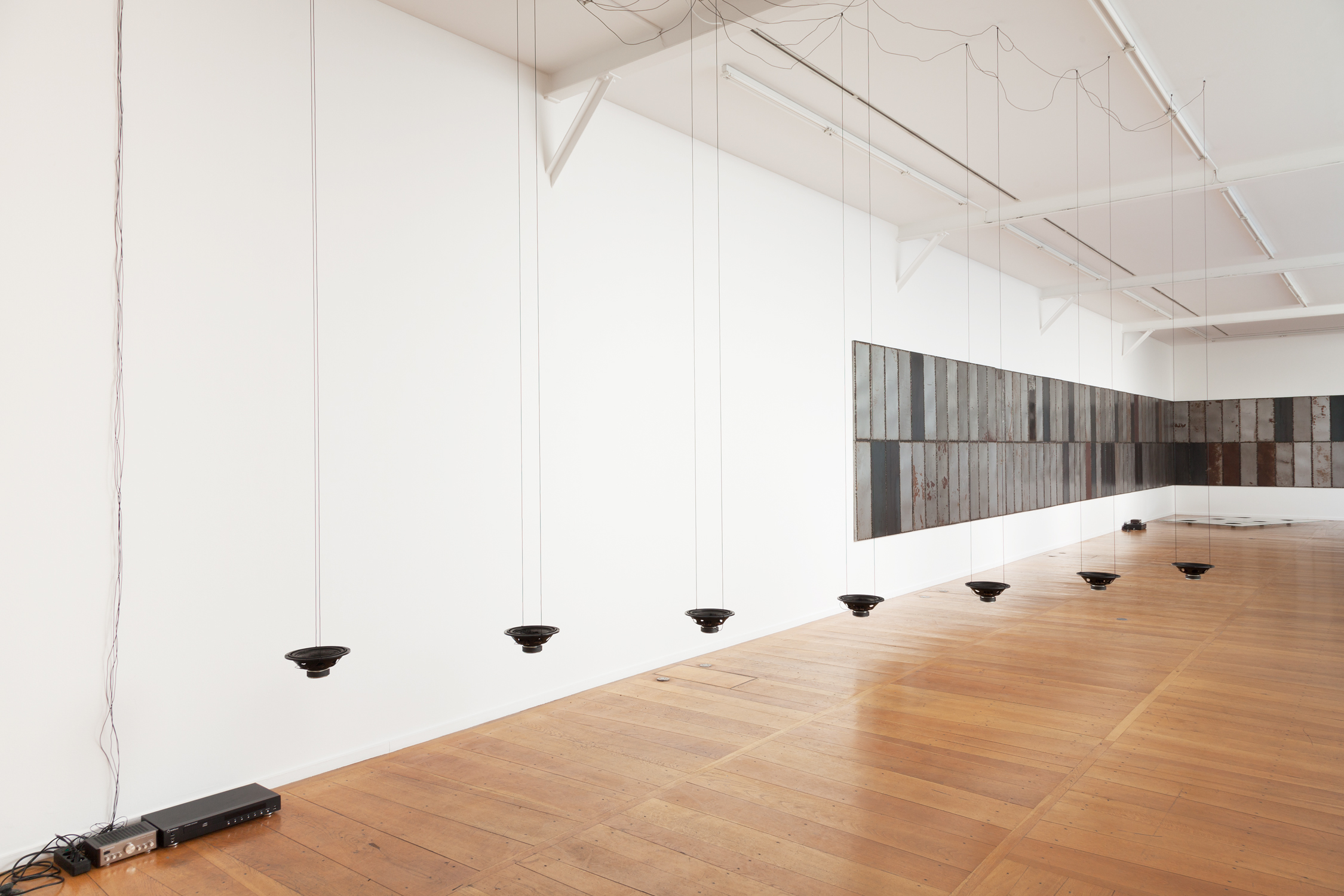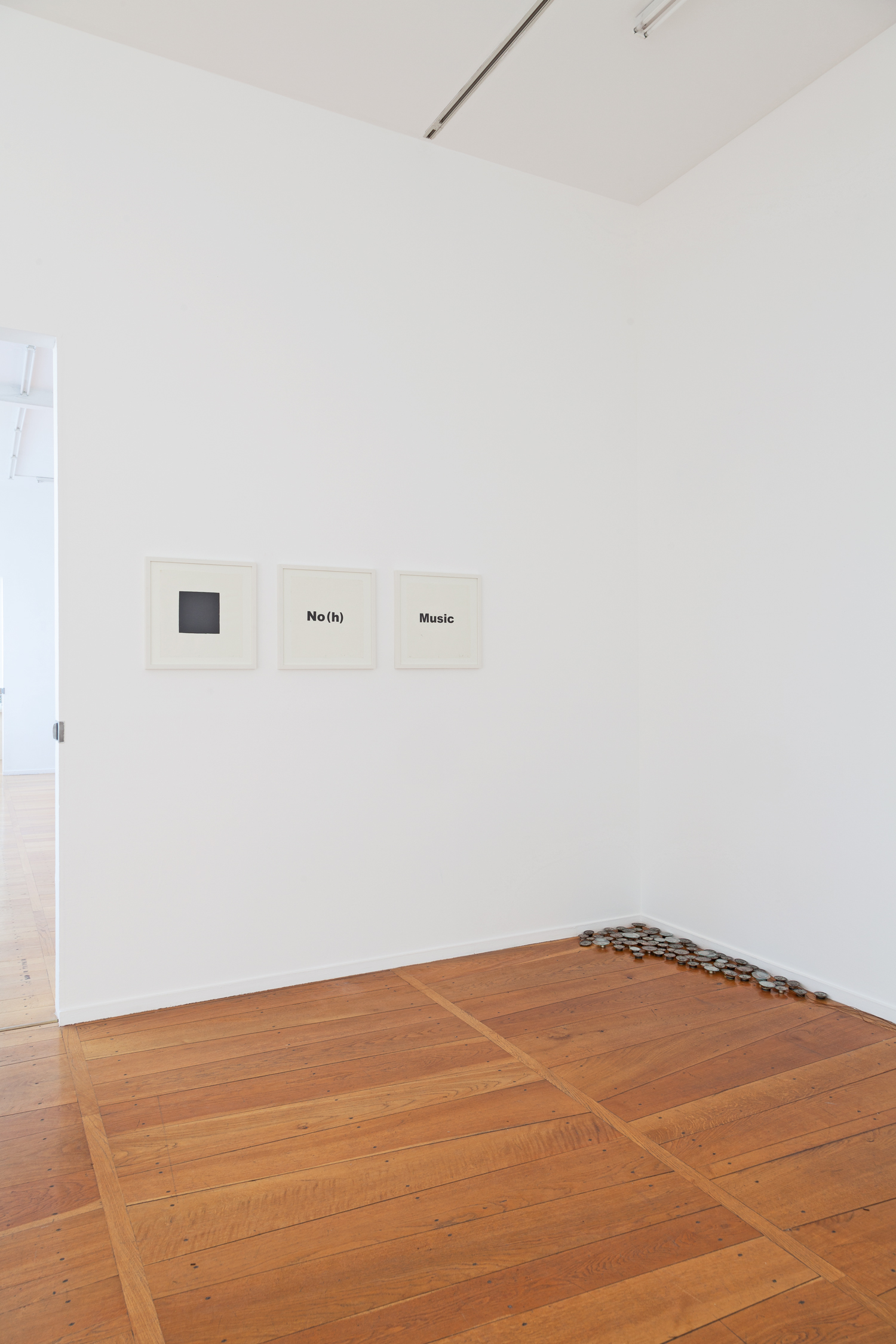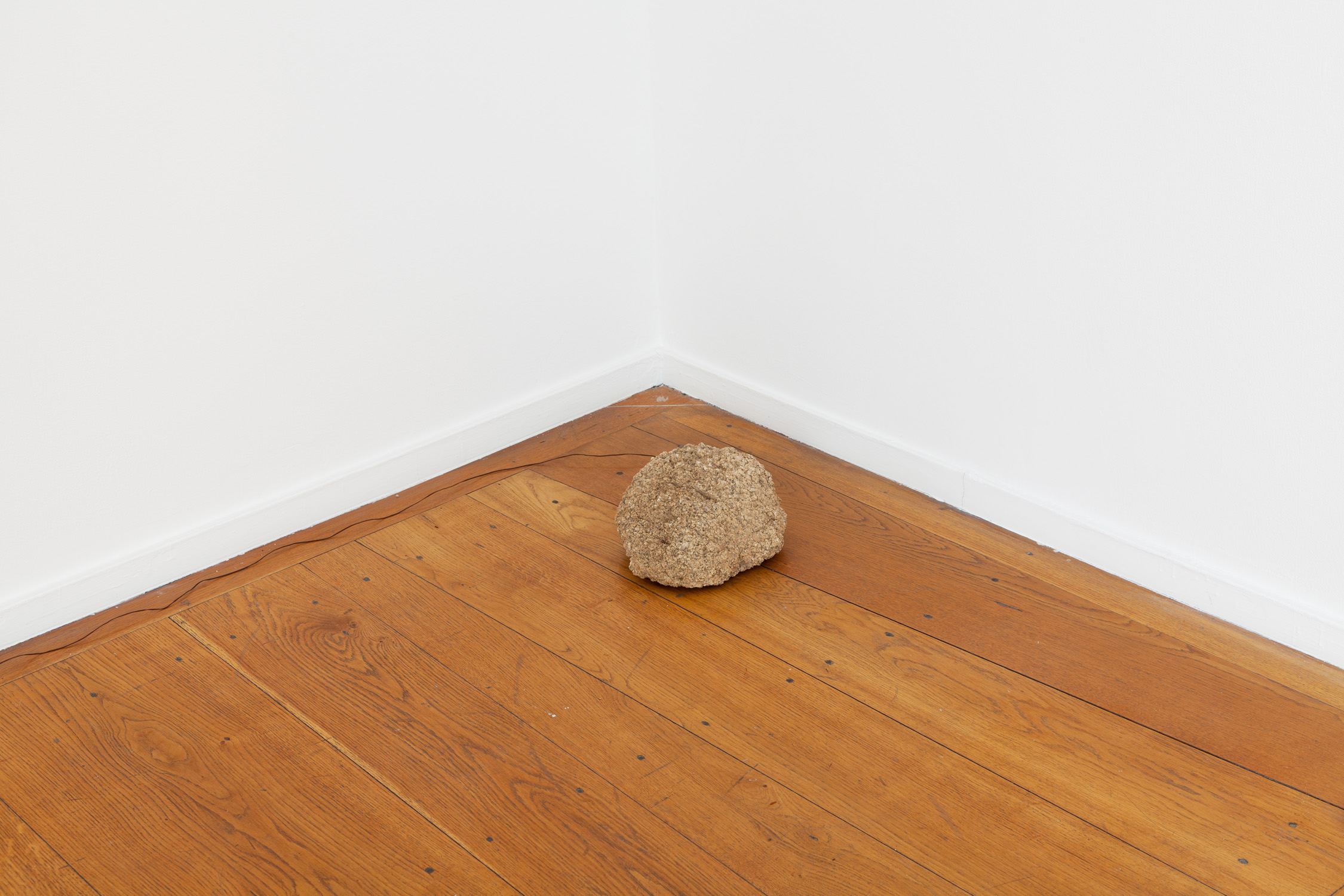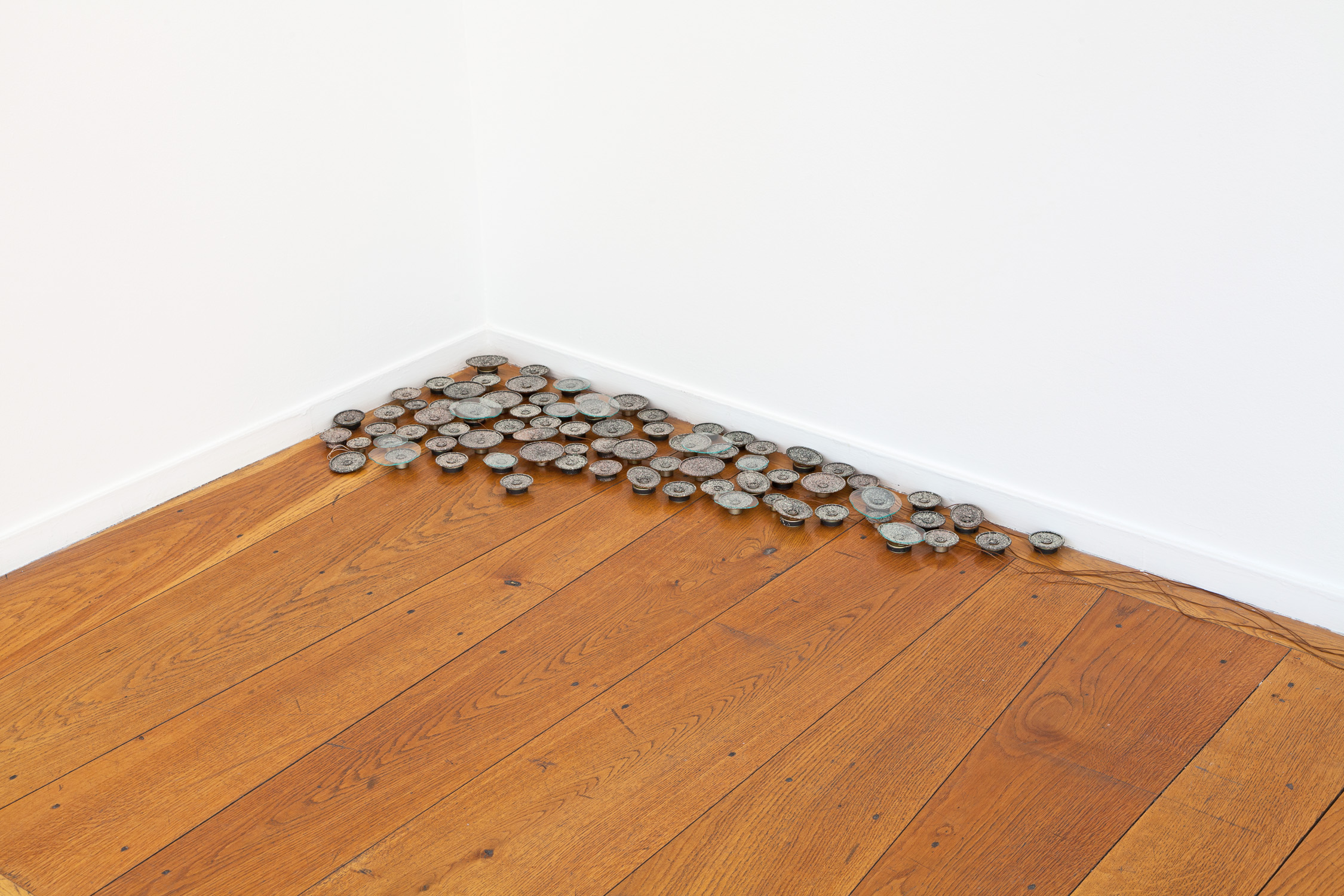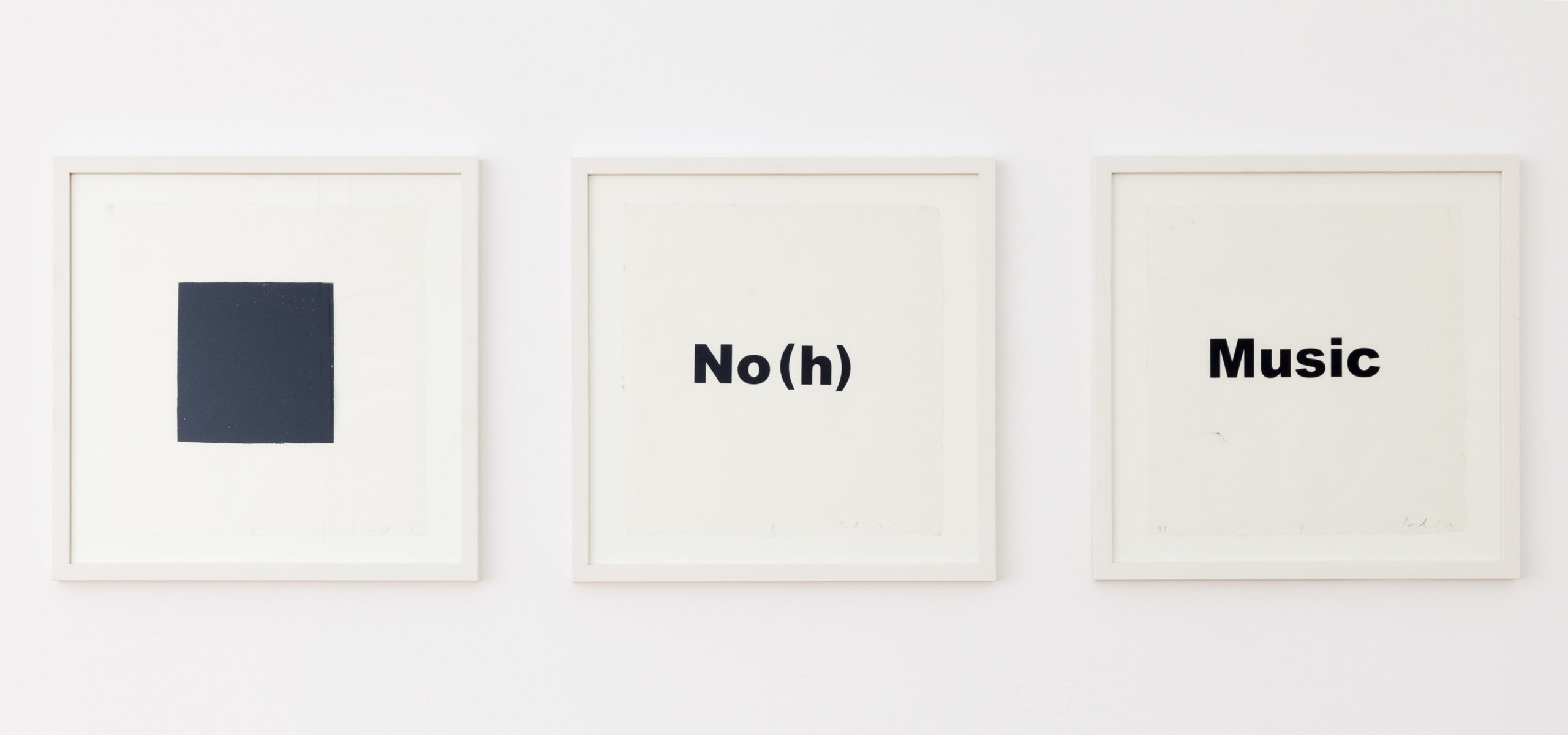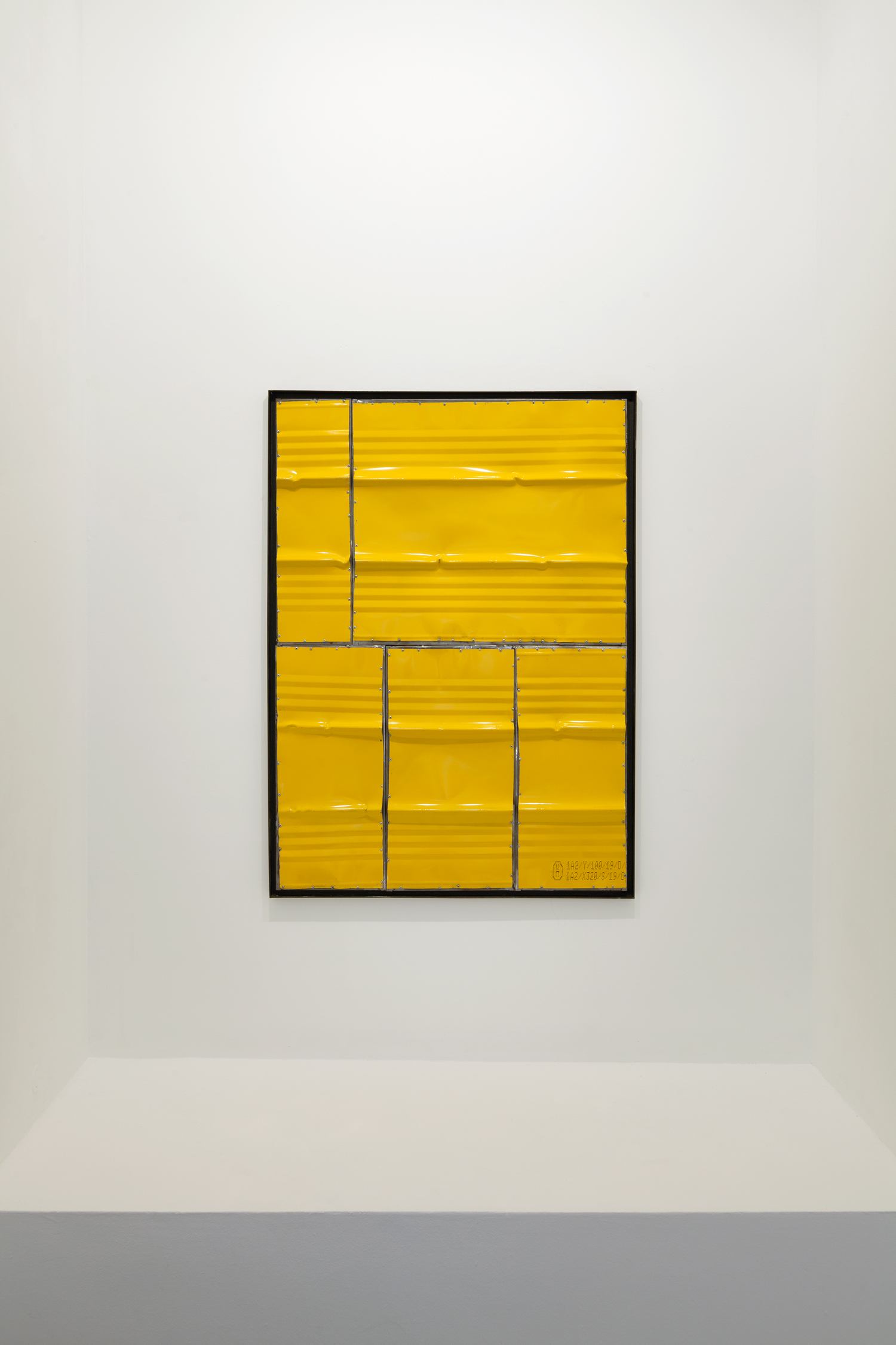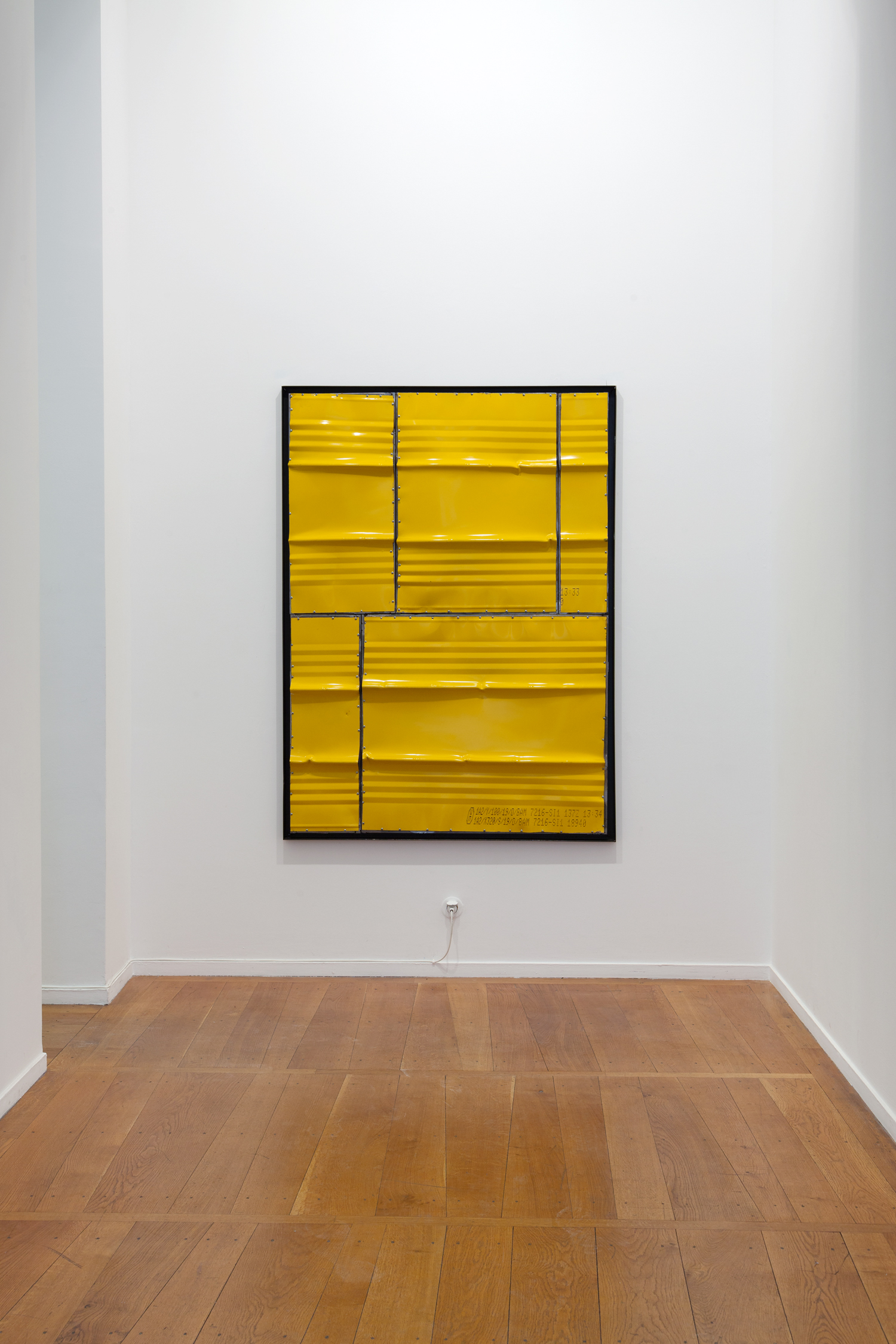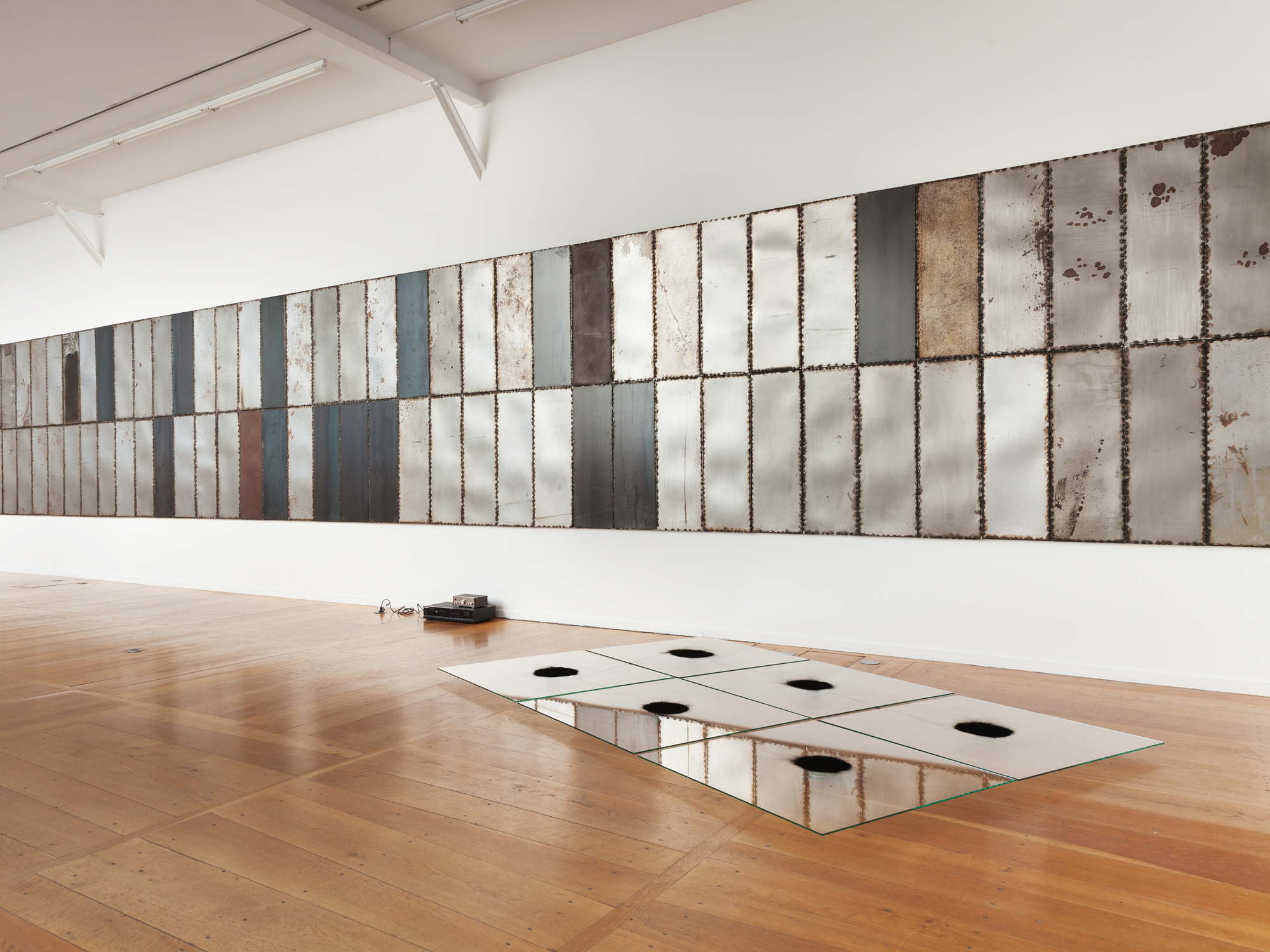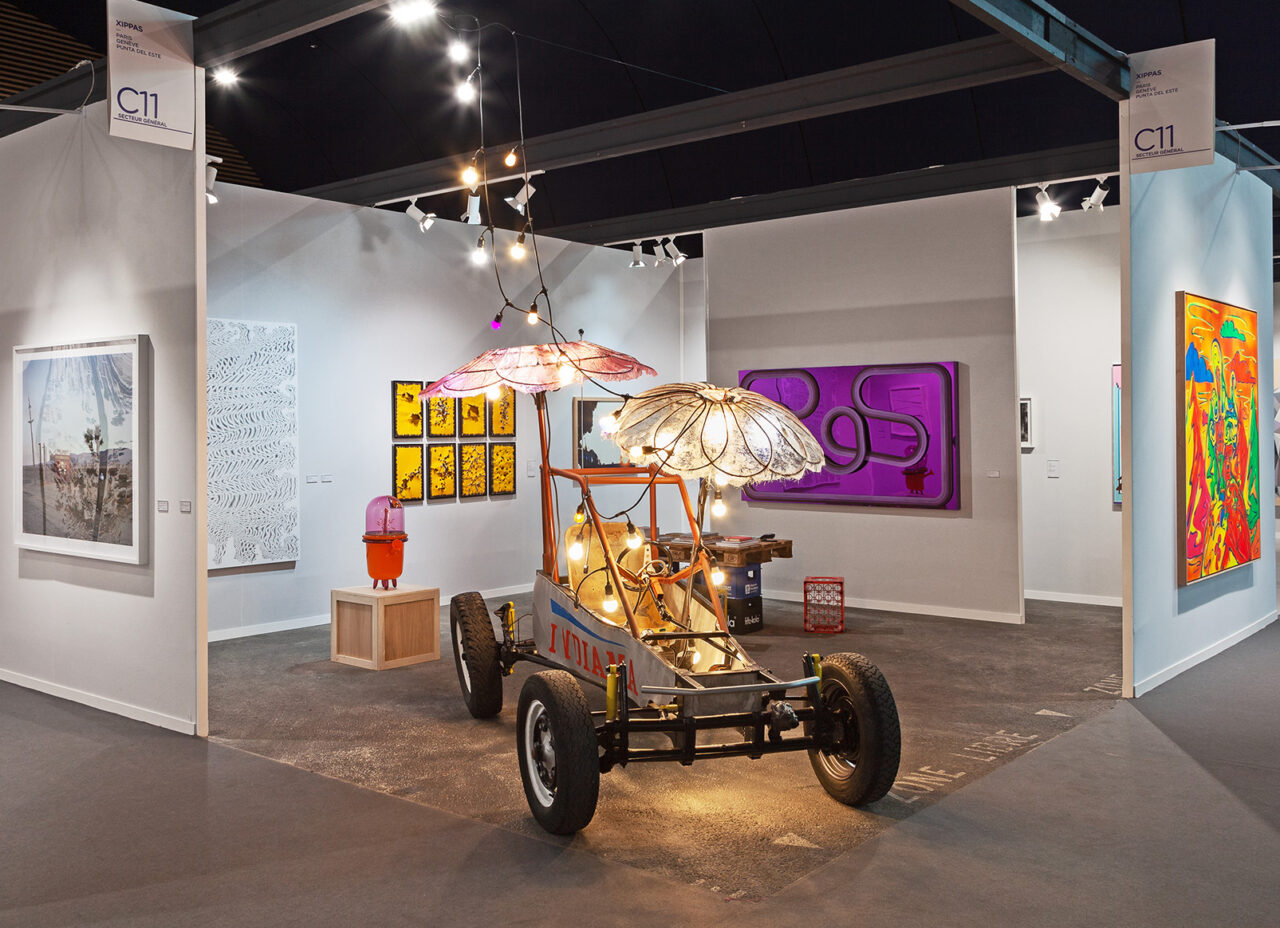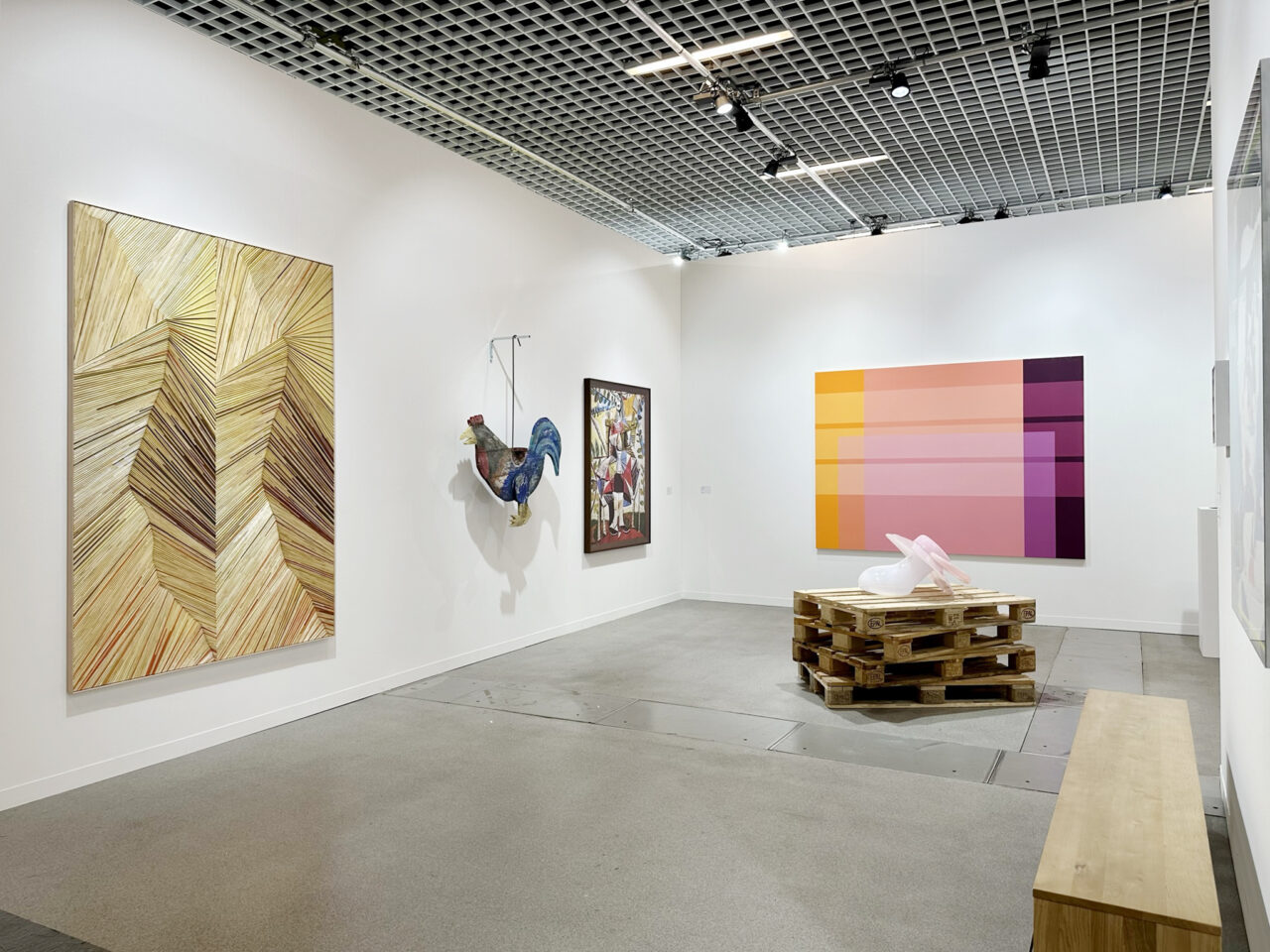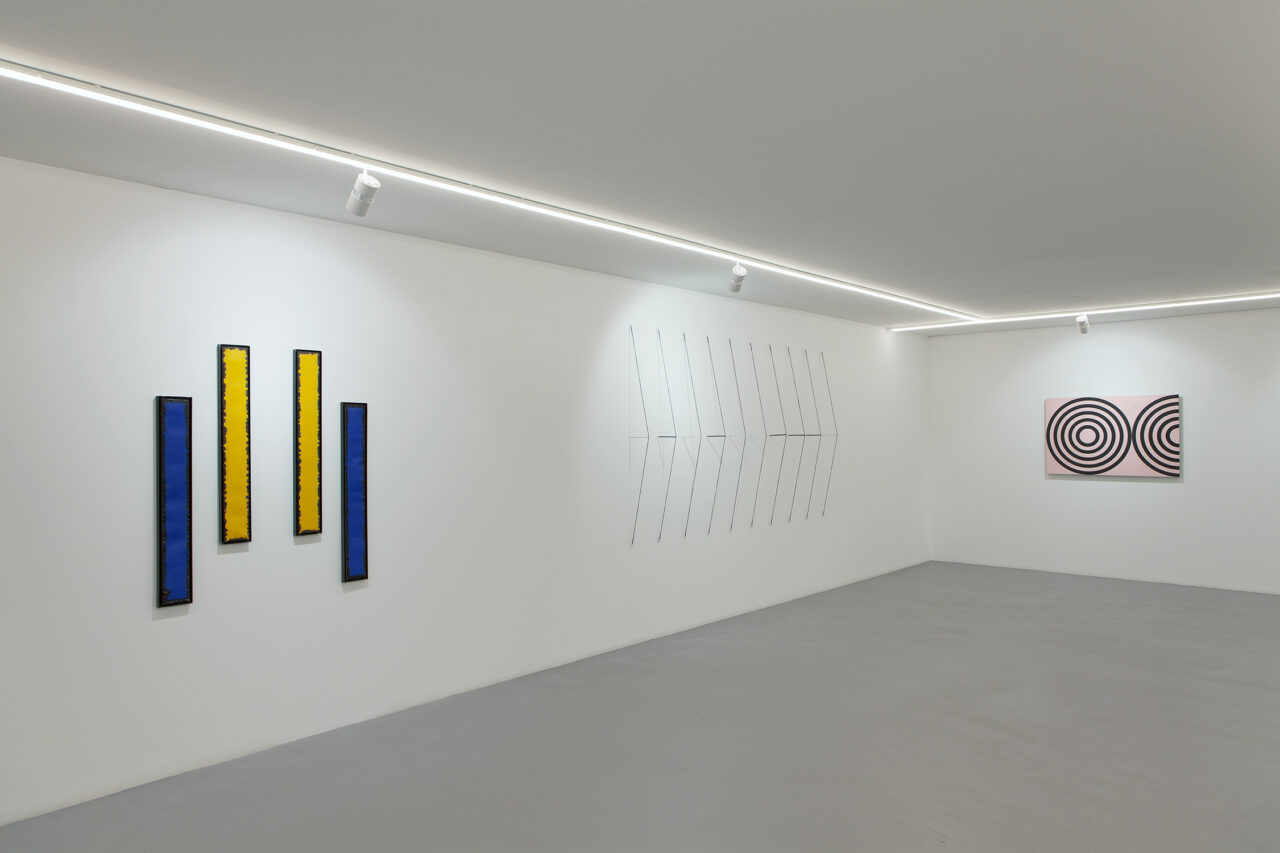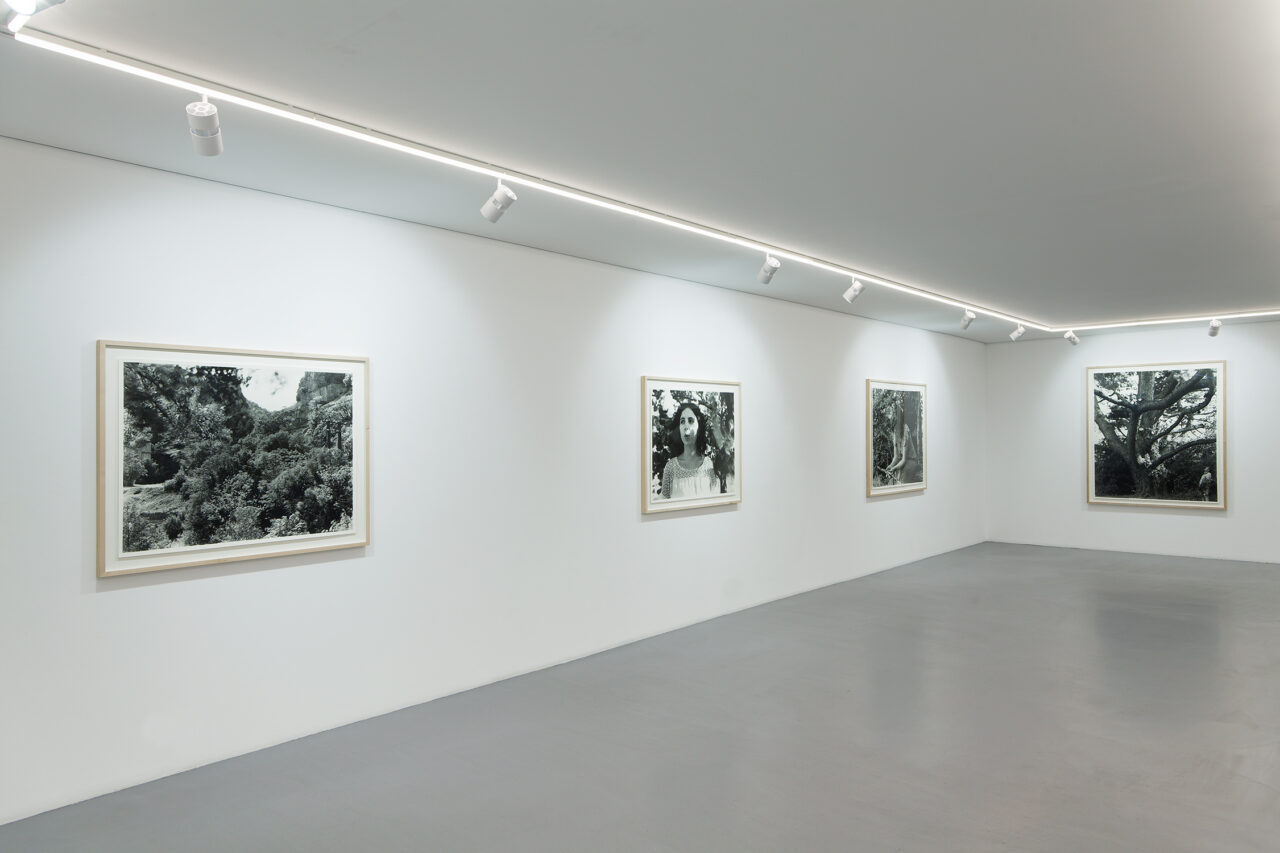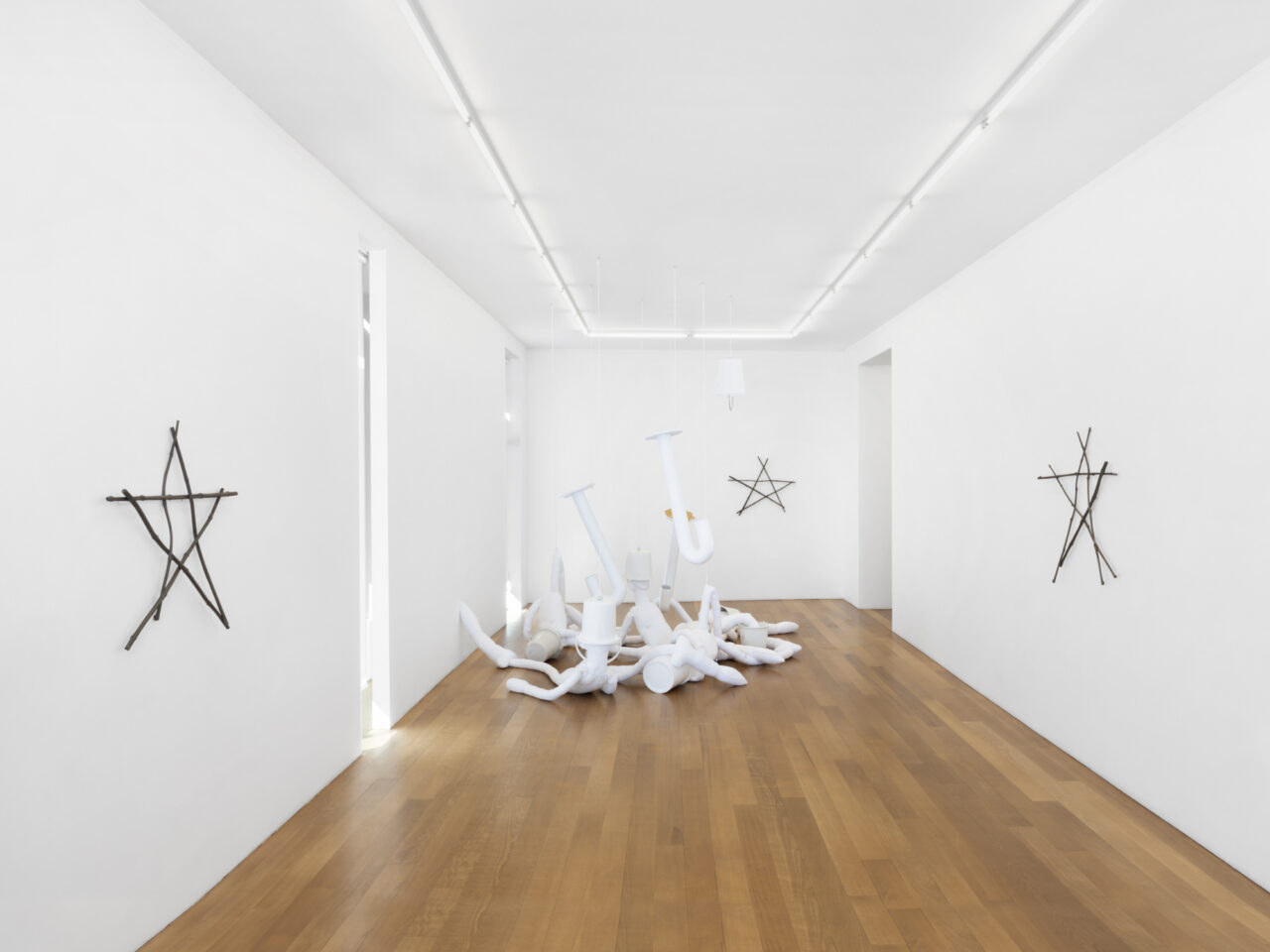Rolf Julius / Kevin Rouillard
Rolf Julius / Kevin Rouillard
26.03.22 → 12.05.22

Exhibition Rolf Julius / Kevin Rouillard takes the form of a surprising dialogue between two artists who have never crossed paths in real life, but who meet here, at Xippas Paris, to transform the gallery into a musical score for two voices. One is an important historical figure in sound art, known for his delicate and often modest interventions: questions, suggestions, whispers in space. The other – a young, upcoming artist who, on the contrary, assertively appropriates the context of the exhibition, making his sculptures unfold on the gallery walls like barricades or testudo formations – like war machines. Although the two visions are rooted in very different contexts and conceptual realities, they present some rhythms in common, rhythms that connect the two worlds like bridges, bringing them closer in time and in space.
Rolf Julius (1939 – 2011) is a German artist who has been known since the 80s for his sculptures and sound installations, as well as his concerts and performances. His exhibitions have taken place in Europe as well as in the two Americas and in Japan, whose aesthetics of small gestures and shadows he felt a particular affinity with.
When one thinks of his work, what comes to mind are not so much objects, stable and defined. Rather, these are “moods” or “atmospheres” or “situations.” “Ecosystems,” in which things and places are enveloped in sounds. Besides, Rolf Julius’ artworks are often designed for specific environments, sometimes literally: loudspeakers placed on the edge of a lake to play a concert for it; small loudspeakers installed in a field or a city centre or in the white cube of a museum or a gallery. They are suspended from the ceiling (Singing), sheltered in Japanese bowls (Blau (innen)) or slipped under floating glass plates (Schwarzes Klavierstück). Modest and humble, they often hide like small wild animals and “decentralise” themselves in space to stay out of the spotlight, settling in corners or on windows or staircases. In the intimacy of their hideouts, they work their magic, mixing sound with other substances, be it language (no(h) music) or pigment (Singing) or dust (Dirt). Since Rolf Julius’ quasi- precarious electronic devices (with the cd players often exposed to the viewer) perform not only in the spaces, but also for them, they run counter to the anthropocentric perspective, insisting on the transient nature of our existence. Delicately affirming that, contrary to the phenomenological position, the world does not require our presence to exist – nor our gaze.
Hence, Rolf Julius’s artworks do not seek to be spectacular. Elegant like drawings in space, with pure lines, they “dissolve” in the name of sound and encourage us to “lend our ears.” To be more attentive too, more attuned to the background hum of existence, and to enter the state of mindful awareness which his small things seem to evoke as they “talk,” or whisper, broadcasting their “small music.” This term “small” should not, however, be taken literally: for Rolf Julius, the question of size is relative, as “big” can be smaller than “small.” After all, in an ideal world, one should be able to see the world in a grain of sand (and why not pigment?) and to hold infinity in the palm of one’s hand, to quote William Blake. Moreover, music is everywhere, as with John Cage, who liberated sound from all objectivity and instrumentalisation, discerning music in the noise of everyday life. Although Rolf Julius met John Cage during his stay in New York, it was Takehisa Kosugi, a Japanese composer and a long-term collaborator of Merce Cunningham, that he became close to. He too sought music in the most ordinary objects. Sharing this vision, Rolf Julius wrote in 1983: “When you leave the sounds alone, the music arises by itself and all the tones, colours, sounds, the loud, soft, small, bent, the yellow, yellowed, off-beat, all feel well.”
As for Kevin Rouillard (b. in 1989), he creates installations and wall sculptures from large cans and containers that he flattens by hammering them. Sometimes he brings together sheets of metal that he welds together to create compositions which seem both complex and simple, since they are made with “poor” materials. Imposing but austere, they result from a process inspired by the logic of recycling. First, Kevin Rouillard collects material which, in turn, is often recycled – indeed, the cans that have already become his signature-material are used in a thousand ways after their nomadic life as transport containers is over, and can be metamorphosed into plates or mobilised in architectural structures. Then, after having recovered the containers, he classifies, organises and transforms them. He brings them back to their ultimate purpose, subtracting them from the circulation of goods in the world. This gesture of subtraction which encourages us to stop running against the clock, a gesture that leads us away from the consumerist logic of consumption, creates a bridge towards the aesthetics of Rolf Julius, who also “recycles” found elements, compelling us to focus on the environment, the context, as we slow down.
When Kevin Rouillard explains how he selects his materials, he specifies that his choice lies outside of any hierarchy. No one piece is privileged over another: all remain equal, purified of their context to become neutral. Even accidental traces that may remain on the surface – a logo fragment or a piece of label – lose their meaning. Persisting beyond any form of storytelling or narrative, beyond conceptualisation too, his pieces attempt to create a zone of pure contemplation in which one may truly encounter the work. This also applies to his monumental installation, the Grand Mur, produced in Mexico in 2020. Although it is impossible to ignore such an obvious reference to the political context, the piece cannot be reduced to a simple critique. Rather, it takes us to the crossroads of themes and issues, touching not only on socio-political issues but also territorial and ecological ones, in order to shape a global vision beyond any judgment. The work becomes a tabula rasa: a space for projection and a plurality of readings. Like an epic poem actualised in space – a “2020 odyssey” – performed by multiple voices.
This vision results in a certain indifference towards the object as an object – reminiscent of Rolf Julius’ work when he lets his “objects” fade away, thereby enabling a multi-sensory experience. As with Rolf Julius, there is no fetishism in the work of Kevin Rouillard. Rather, the object seeks to reach its limits, to become ambivalent. Is it a Duchamp-style ready-made? A sculpture? A diversion of minimalist or Color Field painting? Kevin’s work resists any categorisation and occupies a terminological interstice, inventing a new identity: “sheet metal, shock.” Rolf Julius did something similar when he called his performance pieces “concerts.”
Although Kevin’s artworks cannot be qualified as sound pieces in the strictest sense, their relationship with the gesture that produces them makes them intimately musical – bringing them closer to the works by Rolf Julius. However, while the latter stir internally as they perform, Kevin Rouillard’s pieces “stabilise” the sound, retaining only its memory, and remain mute. Like scores, they embody the visual aspect of music, but also its “tactile” side, a bit like Braille writing. There is a temptation to touch all these asperities on the surface, all these hollows and small bumps, ”wounds” and welding scars, which incidentally make the artworks somehow “human,” giving them a certain sensitivity, not to say fragility, whilst attenuating their warlike appearance. Likewise, upon contact with Rolf Julius, the Grand Mur transforms itself into a musical instrument – a giant xylophone – playing a silent symphony that floats through space.
Exhibition views
-
![Rolf Julius - Kevin Rouillard, Xippas Paris, 2022_15]()
Rolf Julius / Kevin Rouillard, Xippas Paris, March 26 - May 12, 2022
-
![Rolf Julius - Kevin Rouillard, Xippas Paris, 2022_25]()
Rolf Julius / Kevin Rouillard, Xippas Paris, March 26 - May 12, 2022
-
![Rolf Julius - Kevin Rouillard, Xippas Paris, 2022_07]()
Rolf Julius / Kevin Rouillard, Xippas Paris, March 26 - May 12, 2022
-
![Rolf Julius - Kevin Rouillard, Xippas Paris, 2022_12]()
Rolf Julius / Kevin Rouillard, Xippas Paris, March 26 - May 12, 2022
-
![Rolf Julius - Kevin Rouillard, Xippas Paris, 2022_13]()
Rolf Julius / Kevin Rouillard, Xippas Paris, March 26 - May 12, 2022
-
![Rolf Julius - Kevin Rouillard, Xippas Paris, 2022_14]()
Rolf Julius / Kevin Rouillard, Xippas Paris, March 26 - May 12, 2022
-
![Rolf Julius - Kevin Rouillard, Xippas Paris, 2022_17]()
Rolf Julius / Kevin Rouillard, Xippas Paris, March 26 - May 12, 2022
-
![Rolf Julius - Kevin Rouillard, Xippas Paris, 2022_21]()
Rolf Julius / Kevin Rouillard, Xippas Paris, March 26 - May 12, 2022
-
![Rolf Julius - Kevin Rouillard, Xippas Paris, 2022_23]()
Rolf Julius / Kevin Rouillard, Xippas Paris, March 26 - May 12, 2022
-
![Rolf Julius - Kevin Rouillard, Xippas Paris, 2022_03]()
Rolf Julius / Kevin Rouillard, Xippas Paris, March 26 - May 12, 2022
-
![Rolf Julius - Kevin Rouillard, Xippas Paris, 2022_04]()
Rolf Julius / Kevin Rouillard, Xippas Paris, March 26 - May 12, 2022
-
![Rolf Julius - Kevin Rouillard, Xippas Paris, 2022_05]()
Rolf Julius / Kevin Rouillard, Xippas Paris, March 26 - May 12, 2022
-
![Rolf Julius - Kevin Rouillard, Xippas Paris, 2022_06]()
Rolf Julius / Kevin Rouillard, Xippas Paris, March 26 - May 12, 2022
-
![Rolf Julius - Kevin Rouillard, Xippas Paris, 2022_35]()
Rolf Julius / Kevin Rouillard, Xippas Paris, March 26 - May 12, 2022
-
![Rolf Julius - Kevin Rouillard, Xippas Paris, 2022_27]()
Rolf Julius / Kevin Rouillard, Xippas Paris, March 26 - May 12, 2022
-
![Rolf Julius - Kevin Rouillard, Xippas Paris, 2022_web]()
Rolf Julius / Kevin Rouillard, Xippas Paris, March 26 - May 12, 2022
